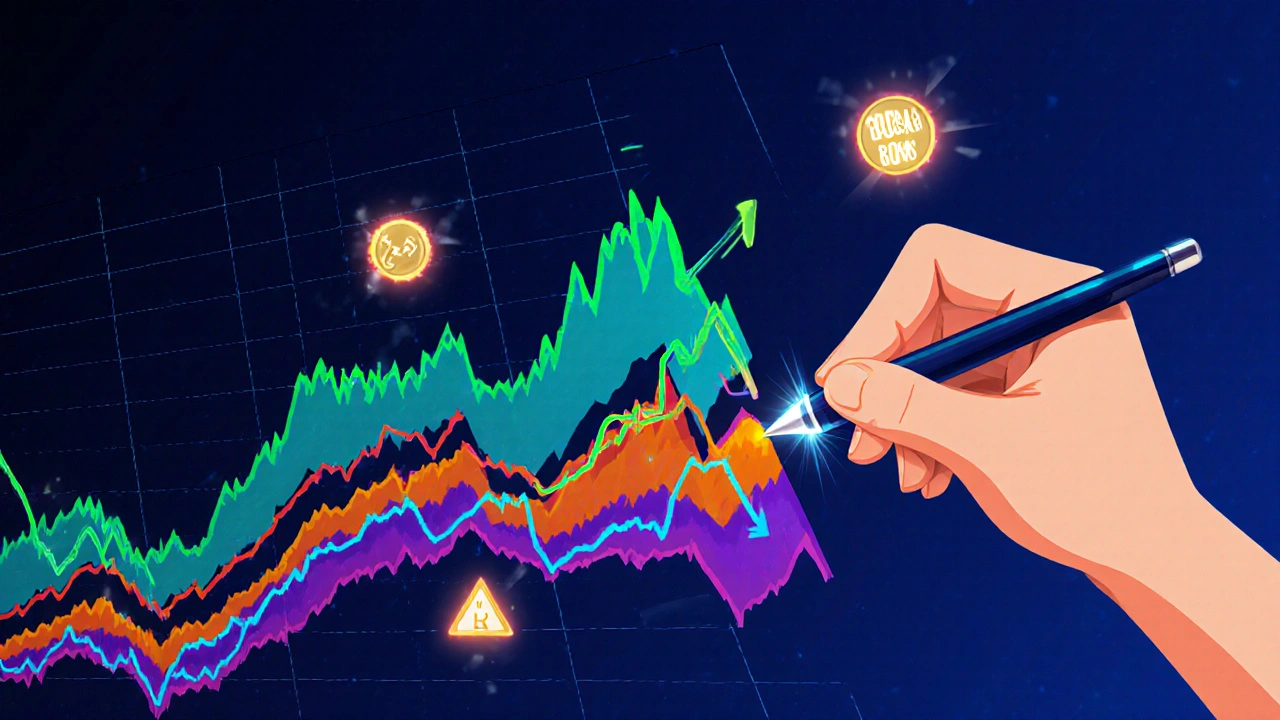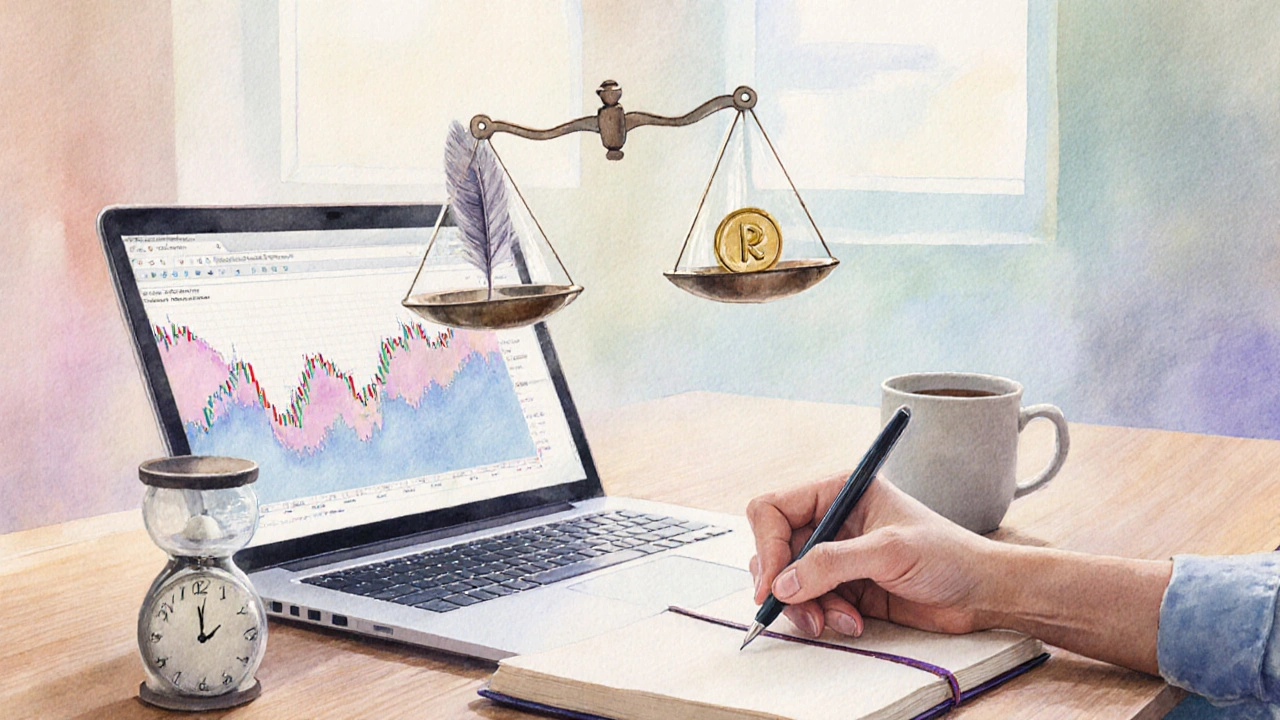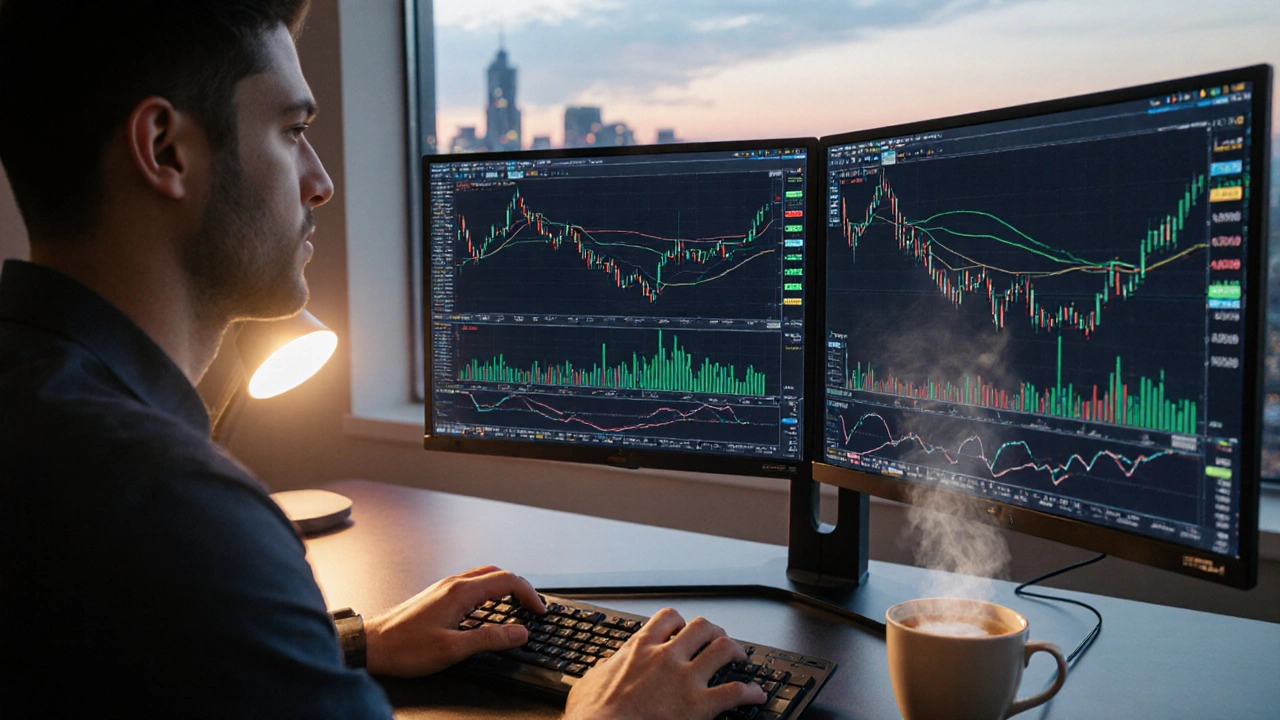Risk Management Calculator
Calculate Your Trade Risk
Determine the maximum position size you should take based on your account size and risk tolerance. This tool implements the 1-2% rule for consistent risk management.
Important: Never risk more than 1-2% of your total account on a single trade. This calculator enforces the 1-2% risk rule for consistent risk management.
When you think about getting better at the markets, Stock Trading is the practice of buying and selling shares to profit from price movements, the first thing most traders want is a clear roadmap. Below are ten actionable strategies that mix proven techniques with everyday habits, so you can move from guessing to trading with confidence. stock trading strategies that actually work are the difference between a hobby and a sustainable side income.
1. Master Technical Analysis
Technical Analysis is the study of price charts, volume, and statistical indicators to forecast future price moves. Start with the basics: trend lines, moving averages, and momentum oscillators like RSI. Spend a few minutes each day scanning charts for repeated patterns; over time you’ll start to recognize high‑probability setups. A quick tip: combine at least two indicators (e.g., MACD + 50‑day SMA) to filter out false signals.
2. Dive Into Fundamental Analysis
Fundamental Analysis looks at a company’s financial health, competitive position, and growth prospects by reviewing earnings reports, balance sheets, and industry trends. Focus on a handful of metrics such as P/E ratio, ROE, and free cash flow. When a stock’s fundamentals are solid but the price is distracted by short‑term noise, you often find the best long‑term entries.
3. Build a Risk Management Framework
Risk Management protects your capital by defining how much you’re willing to lose on any single trade. The most common rule is the 1‑2% rule: never risk more than 2% of your account on one position. Use stop‑loss orders to enforce the rule and always calculate position size before you click “Buy”. Consistent risk control keeps you in the game for the long haul.
4. Sharpen Your Trading Psychology
Trading Psychology deals with the mental habits that affect decision‑making such as fear, greed, and over‑confidence. Keep a journal of your emotions after each trade and notice patterns-do you chase losses after a bad day? Practicing mindfulness or a short breathing break before entering a trade can dramatically improve discipline.

5. Use Chart Patterns Effectively
Chart Patterns are repeating formations on price charts that signal continuation or reversal. Classic examples include head‑and‑shoulders, double tops, and triangles. Learn the entry, target, and stop criteria for each pattern, then back‑test them on historical data. The more patterns you master, the more setups you’ll spot in real time.
6. Leverage Candlestick Patterns
Candlestick Patterns give you a quick visual cue about market sentiment through the shape of individual price bars. Look for bullish engulfing, hammer, and shooting star formations near key support or resistance levels. Pair a candlestick signal with a larger trend to boost reliability.
7. Apply Moving Averages Wisely
Moving Averages smooth out price data to highlight the underlying trend by averaging closing prices over a set period. The 20‑day EMA works well for short‑term traders, while the 200‑day SMA helps identify long‑term direction. When a fast average crosses above a slow one (a “golden cross”), many traders treat it as a bullish signal.

8. Identify Support and Resistance Levels
Support and Resistance are price zones where buying or selling pressure historically intensifies. Draw them by connecting recent lows (support) or highs (resistance). Breakouts above resistance often lead to strong moves, while bounces off support can signal a bounce back up.
9. Keep a Detailed Trading Journal
Recording every trade-including entry price, rationale, stop‑loss, and outcome-lets you spot strengths and weaknesses. Over weeks, patterns emerge: maybe you’re better at swing trades than scalps, or you consistently over‑size positions when volatility spikes. Use a simple spreadsheet or a dedicated app; the key is consistency.
10. Practice With Simulated Trading
Before committing real money, spend at least a month on a paper‑trading platform. Treat the virtual account exactly like a live one: apply the same risk limits, log every trade, and critique your decisions. Simulated trading helps you internalize the rules from the previous nine strategies without the stress of real losses.
| Strategy | Core Tool / Indicator | Typical Timeframe | Key Benefit |
|---|---|---|---|
| Technical Analysis | RSI, MACD, Trend Lines | Intraday to Weekly | Spot high‑probability entry points |
| Fundamental Analysis | Earnings Reports, P/E Ratio | Quarterly to Yearly | Identify undervalued stocks |
| Risk Management | Position‑size calculators | All horizons | Protect capital from big losses |
| Trading Psychology | Journaling, Mindfulness | All horizons | Reduce emotional trading |
| Chart Patterns | Head‑and‑Shoulders, Triangles | Daily to Monthly | Predict trend reversals |
| Candlestick Patterns | Engulfing, Hammer | Intraday to Daily | Quick sentiment clues |
| Moving Averages | 20‑EMA, 200‑SMA | Daily to Weekly | Clarify trend direction |
| Support & Resistance | Horizontal zones | All horizons | Identify breakout zones |
| Trading Journal | Spreadsheet, Apps | Ongoing | Continuous performance review |
| Simulated Trading | Paper‑trading platforms | 1‑Month trial | Build confidence risk‑free |
Next Steps and Common Pitfalls
Start by picking three strategies that feel most relevant to your current style. Implement them one at a time; trying to overhaul everything in a week usually ends in burnout. Watch out for over‑optimization-adding too many indicators can create analysis paralysis. Remember, consistency beats perfection.
How much capital do I need to start applying these strategies?
There’s no magic number, but most experts recommend starting with at least $1,000 to allow meaningful position sizing while keeping risk per trade under 2%.
Can I use these strategies for forex or crypto markets?
Absolutely. The core principles-technical analysis, risk management, psychology-apply across any liquid market. Adjust timeframes and volatility buffers accordingly.
How often should I review my trading journal?
A weekly review catches short‑term patterns, while a monthly deep‑dive highlights strategic trends. Consistency is key.
What’s the best way to set stop‑loss levels?
Place stops just beyond recent support or resistance zones, or use a multiple of the Average True Range (ATR) to account for volatility.
Should I use more than one moving average?
Yes. Pair a short‑term average (like 20‑EMA) with a longer one (200‑SMA) to spot crossovers that signal trend shifts.



Tamil selvan
October 23, 2025 AT 11:04First of all, congratulations on taking the initiative to refine your trading craft; the road to consistent profitability is paved with disciplined study, continual practice, and mindful risk management. By embracing both technical and fundamental analysis, you create a robust decision‑making framework, which, when coupled with a well‑structured journal, yields measurable improvement over time. Remember to allocate no more than 2 % of your capital per trade, and always set stop‑losses just beyond recent support or resistance zones; this simple habit safeguards your portfolio against unforeseen volatility. Additionally, integrating mindfulness techniques-such as a brief breathing exercise before entering a position-can dramatically reduce emotional bias, allowing you to stick to your plan with confidence. Keep iterating on these strategies, and you’ll find that consistency truly does outweigh occasional brilliance.
Mark Brantner
October 24, 2025 AT 03:44Oh great, another “magic 1% rule” to whisper into my ear while the market crashes.
amber hopman
October 24, 2025 AT 19:01I love the emphasis on a trading journal; it’s essential to track not just outcomes but the reasoning behind each entry, which eventually reveals hidden biases and helps fine‑tune your strategy.
Kathy Yip
October 25, 2025 AT 08:54Indeed, the journal acts as a mirror reflecting our internal narratives; when we confront the dissonance between expectation and reality, we uncover the deeper psychological patterns that drive our trading behavior.
Mbuyiselwa Cindi
October 25, 2025 AT 22:14Good point on the 2 % risk cap. In practice, I use a position‑size calculator that also factors in ATR, so my stops aren’t just static levels but adapt to current volatility-a small tweak that makes a big difference.
Krzysztof Lasocki
October 26, 2025 AT 10:18Honestly, if you think a 15‑minute moving‑average crossover will magically turn you into a Wall Street wizard, you’re in for a rude awakening; markets love to punish over‑confidence just as much as they reward patience.
Henry Kelley
October 26, 2025 AT 23:04True, the crossover can be a useful signal, but pairing it with volume spikes and checking the broader trend usually filters out the noise-just remember not to over‑rely on any single indicator.
Victoria Kingsbury
October 27, 2025 AT 11:34From a macro perspective, aligning your strategy windows with major economic releases can boost signal reliability; the liquidity influx often creates clearer patterns for both candlesticks and support‑resistance breaks.
Tonya Trottman
October 27, 2025 AT 23:48While it’s “common knowledge” that news can move markets, the real art lies in quantifying the impact-simply saying “watch the releases” ignores the fact that multiple data points can interact, producing non‑linear price reactions that defy naive expectations.
Ray Htoo
October 28, 2025 AT 11:44One aspect that many traders overlook is the importance of calibrating their risk appetite to their personal life circumstances; a trader with a stable 9‑to‑5 job can afford to allocate a smaller portion of capital per trade compared to someone whose primary income depends on trading profits. This calibration begins with a honest assessment of living expenses, emergency funds, and the psychological tolerance for drawdowns. After establishing a baseline, the next step is to back‑test each of the ten strategies in the article using a consistent dataset, ensuring that take‑profit and stop‑loss levels are applied uniformly across all scenarios. During this back‑testing phase, I recommend logging not only win‑rate and average reward‑to‑risk ratios but also the maximum consecutive losses, as this metric reveals potential emotional strain points. Once the data is collected, construct a heat map to visualize which strategies perform best under varying market regimes-bullish, sideways, or bearish-allowing you to dynamically allocate capital based on the prevailing environment. Moreover, consider incorporating a portfolio‑level risk model, such as the Kelly criterion, to fine‑tune position sizing for each strategy while preventing over‑leverage. It’s also prudent to schedule periodic “strategy audits” every quarter, where you revisit the journal entries, compare them against actual outcomes, and adjust parameters like moving‑average periods or ATR multipliers accordingly. To maintain discipline, set up automated alerts that notify you when a trade deviates from the predefined risk parameters, thereby reducing the temptation to intervene impulsively. In addition, diversifying across asset classes-stocks, ETFs, commodities, or even crypto-can smooth equity curve volatility, as not all markets move in sync. Finally, remember that continuous learning is a cornerstone of long‑term success; allocate time each week to read research papers, attend webinars, or discuss ideas with a trading community, because the collective intelligence often surfaces insights that solitary analysis misses. By embedding these systematic habits into your routine, you transform the ten strategies from a static checklist into a living, adaptable framework that evolves with both market conditions and personal growth.
Natasha Madison
October 28, 2025 AT 23:24Sure, but don’t forget the market is secretly manipulated; those “risk models” are just smoke screens for the elite.
Sheetal Srivastava
October 29, 2025 AT 10:48While the prose extols diligence, it neglects the epistemological asymmetry inherent in financial cognition; without a meta‑theoretical lens, one merely skims the surface of market dynamics, succumbing to superficial heuristics that ultimately erode capital.